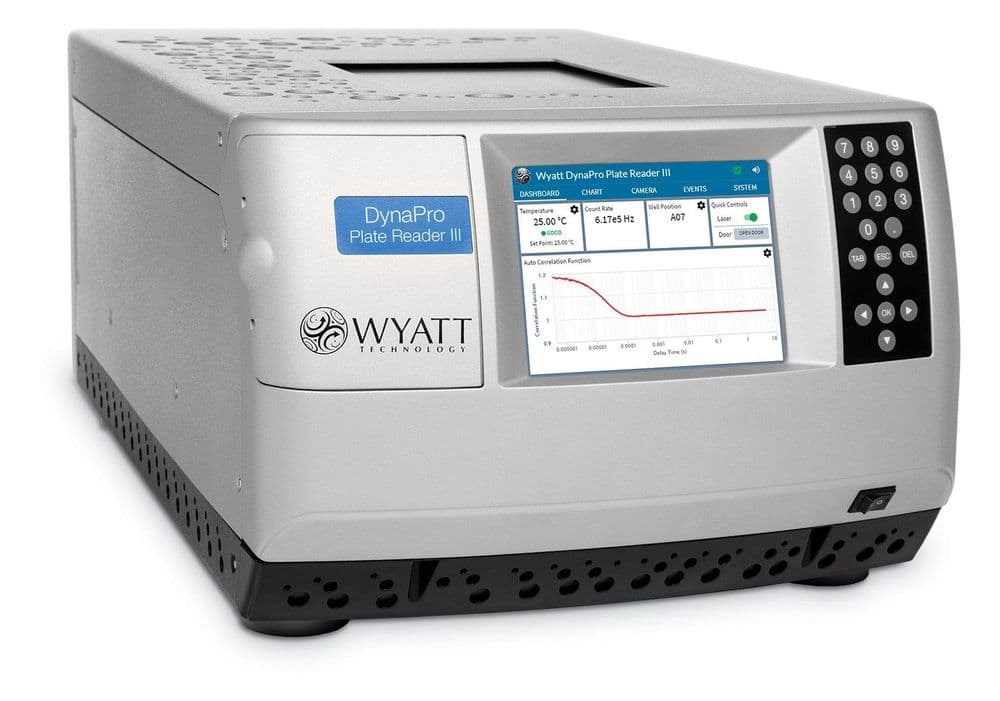info@universallab.org
WhatsApp: +41762172997



Price may vary based on selected options
Delivery time: 1 ~ 2 weeks
DLS (Dynamic Light Scattering) is a non-invasive technique for measuring the size distribution of nanoparticles and colloidal particles in suspension. It is widely used to characterize particle size, aggregation state, and stability of colloidal systems.
Hydrodynamic Diameter (Dh) — Measures the effective diameter of particles in a liquid, accounting for the solvation layer
Polydispersity Index (PDI) — Indicates the width of the particle size distribution; low values reflect uniformity
Aggregation Detection — Reveals the presence of particle clusters or flocculation
Zeta Potential (optional, with DLS+Electrophoresis) — Provides insight into surface charge and colloidal stability
Temperature-Dependent Size — Monitors particle swelling, shrinkage, or aggregation under varying conditions
DLS is particularly important in nanomaterials research, pharmaceuticals, polymers, and colloidal chemistry, offering rapid, reliable particle characterization before advanced imaging or scattering methods are applied.
DLS analysis is versatile and suitable for aqueous and organic suspensions, nanoparticles, proteins, polymers, and emulsions. The technique is non-destructive and requires minimal sample preparation.
DLS is often combined with TEM, SEM, AFM, NTA to provide complementary size and morphology information. For example, DLS gives bulk hydrodynamic size, while TEM visualizes individual particle shapes.
DLS measures fluctuations in light scattering intensity caused by Brownian motion of particles in suspension. Smaller particles move faster, producing faster intensity fluctuations, while larger particles move slower. By analyzing the autocorrelation function of scattered light, the hydrodynamic diameter and polydispersity index are calculated.
1. Why is the PDI high (>0.3)?
A: High polydispersity indicates a wide size distribution, which may be caused by aggregation, impurities, or sample preparation issues.
2. Why are the results different from TEM?
A: DLS measures hydrodynamic size in liquid (including solvation layer), while TEM measures dry particle core size. Discrepancies are expected and complementary.
3. Why do I see a second peak?
A: Possible reasons include:
DLS analysis is versatile and suitable for aqueous and organic suspensions, nanoparticles, proteins, polymers, and emulsions. The technique is non-destructive and requires minimal sample preparation.
Example of DLS results.
| Parameter | Value |
|---|---|
| Hydrodynamic Diameter (Z-average) | 85.3 nm |
| Polydispersity Index (PDI) | 0.12 |
| Zeta Potential (if measured) | -32.4 mV |
| Particle Size Distribution Range | 60–110 nm |


To ensure accurate DLS results:
Contact our team for guidance on preparing challenging samples.
1 Caption: Schematic illustration of DLS measurement principle

The DLS measurement process includes the following steps:
Measurements are conducted using fully automated, high-precision DLS instruments to ensure accuracy and repeatability.
To ensure accurate DLS results:
Contact our team for guidance on preparing challenging samples.
Comparison of Particle Size Analysis Methods (Method as Columns)
| Attribute | DLS | NTA | TEM/SEM | AFM | Laser Diffraction |
|---|---|---|---|---|---|
| Working Principle | Measures Brownian motion via light scattering | Tracks individual particle movement | Electron imaging of dry particles | Atomic probe scanning of surface | Mie scattering of bulk sample |
| Size Range | 1 nm – 1 µm | 10 nm – 2 µm | 1 nm – µm | 1 nm – µm | 0.1 µm – 3 mm |
| Strengths | Rapid, non-destructive, minimal sample | Size distribution of heterogeneous samples | High-resolution imaging | 3D surface topography | Large particles and polydisperse systems |
| Limitations | Sensitive to aggregates; requires dilute sample | Limited by particle concentration | Sample drying may cause artifacts | Slow and low throughput | Less sensitive to small nanoparticles |
| Recommended Materials | Nanoparticles, colloids, polymers | Proteins, nanoparticles | Nanoparticles, colloids | Thin films, surfaces | Powders, suspensions |
2 Caption: Overview of particle size analysis methods
Advantages:
Limitations:
Example of DLS results.
| Parameter | Value |
|---|---|
| Hydrodynamic Diameter (Z-average) | 85.3 nm |
| Polydispersity Index (PDI) | 0.12 |
| Zeta Potential (if measured) | -32.4 mV |
| Particle Size Distribution Range | 60–110 nm |


1. Why is the PDI high (>0.3)?
A: High polydispersity indicates a wide size distribution, which may be caused by aggregation, impurities, or sample preparation issues.
2. Why are the results different from TEM?
A: DLS measures hydrodynamic size in liquid (including solvation layer), while TEM measures dry particle core size. Discrepancies are expected and complementary.
3. Why do I see a second peak?
A: Possible reasons include:
DLS (Dynamic Light Scattering) is a non-invasive technique for measuring the size distribution of nanoparticles and colloidal particles in suspension. It is widely used to characterize particle size, aggregation state, and stability of colloidal systems.
Hydrodynamic Diameter (Dh) — Measures the effective diameter of particles in a liquid, accounting for the solvation layer
Polydispersity Index (PDI) — Indicates the width of the particle size distribution; low values reflect uniformity
Aggregation Detection — Reveals the presence of particle clusters or flocculation
Zeta Potential (optional, with DLS+Electrophoresis) — Provides insight into surface charge and colloidal stability
Temperature-Dependent Size — Monitors particle swelling, shrinkage, or aggregation under varying conditions
DLS is particularly important in nanomaterials research, pharmaceuticals, polymers, and colloidal chemistry, offering rapid, reliable particle characterization before advanced imaging or scattering methods are applied.